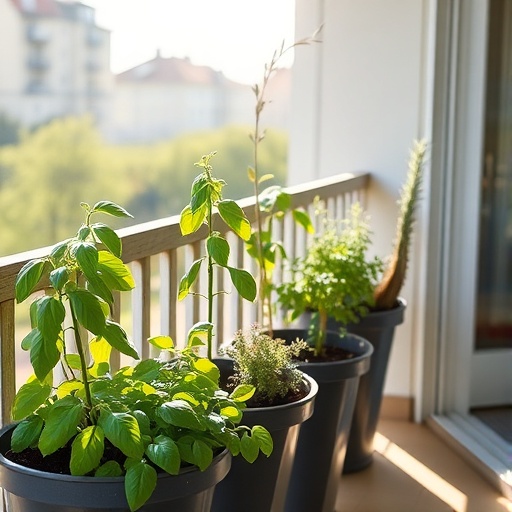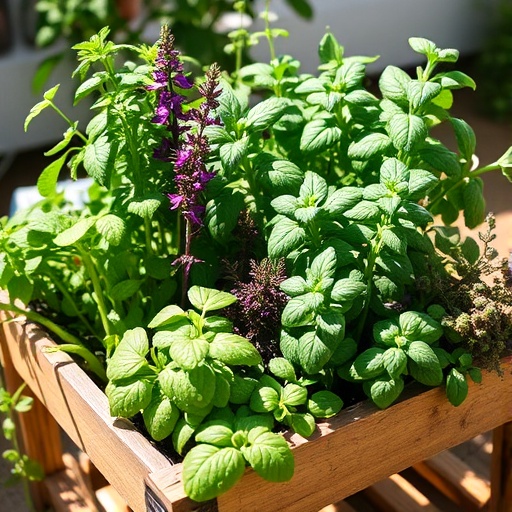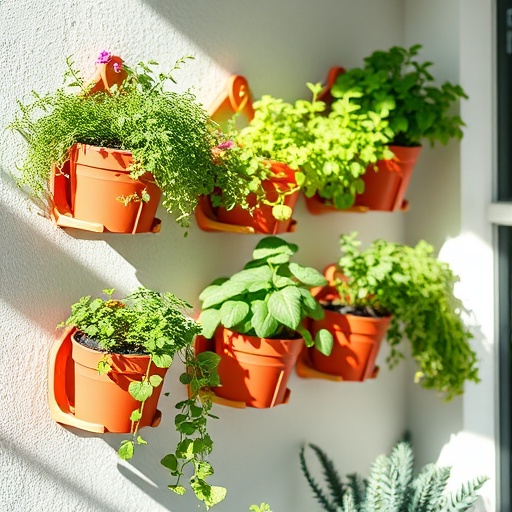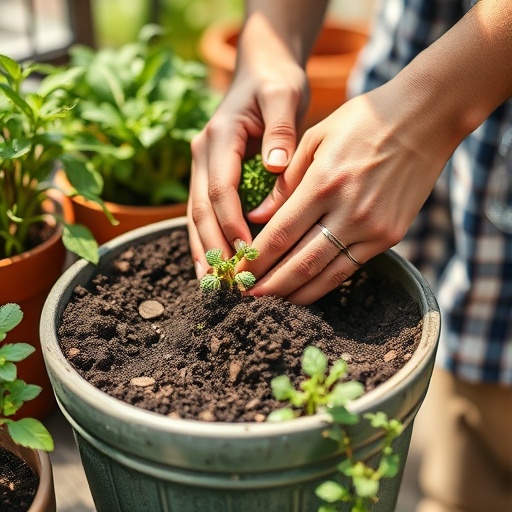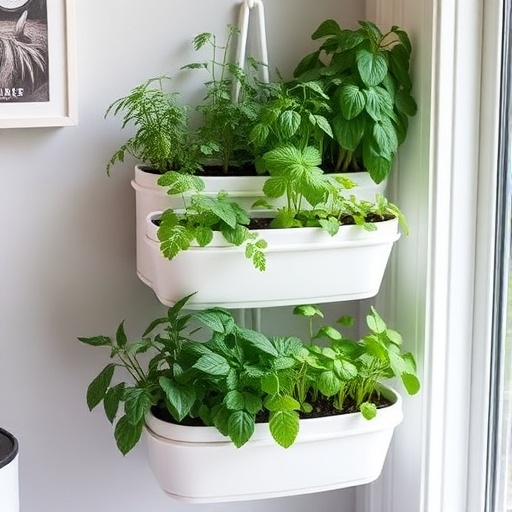Introduction
Have you ever gazed out at your small balcony or apartment space and wished you could cultivate fresh, aromatic herbs right at home? Many people believe that gardening requires a sprawling backyard, but I’m here to tell you that’s simply not true! Creating a thriving balcony herb garden for apartments is not only achievable but also incredibly rewarding. Imagine snipping fresh basil for your pasta, rosemary for your roasted potatoes, or soothing mint for your tea, all from a charming container garden just steps away. This comprehensive guide will equip you with the knowledge and confidence to transform your compact outdoor area into a verdant oasis, brimming with fragrant and delicious herbs. Get ready to embrace the joy of urban gardening, even in the smallest of spaces!
Tools & Materials Needed
Embarking on your balcony herb garden journey doesn’t require a massive investment in specialized equipment. Here’s a detailed list of what you’ll need, along with some eco-friendly and budget-conscious alternatives:
- Pots and Containers: The foundation of your balcony herb garden.
- Recommendation: Opt for pots with drainage holes to prevent root rot. Terracotta pots are excellent for herbs like rosemary and thyme that prefer drier conditions, as they allow for good airflow. Glazed ceramic or plastic pots retain moisture longer, suitable for basil or mint.
- Eco-friendly/Budget Alternative: Repurpose old food containers (yogurt tubs, milk jugs) or even sturdy coffee cans. Just make sure to punch several drainage holes in the bottom. Vertical planters are also fantastic for maximizing space, turning your small balcony into a tiered herb paradise.
- Quality Potting Mix: This is crucial for healthy herb growth.
- Recommendation: Look for an organic potting mix that’s well-draining and rich in nutrients. Avoid garden soil, which can compact and harbor pests when used in containers.
- Eco-friendly/Budget Alternative: Create your own mix by blending compost, coco coir (a sustainable alternative to peat moss), and perlite for aeration.
- Herb Seeds or Seedlings: The stars of your garden!
- Recommendation: For beginners, starting with seedlings is often easier as they are already established. Popular choices for a balcony herb garden for apartments include basil, mint, chives, parsley, rosemary, and thyme.
- Eco-friendly/Budget Alternative: Save seeds from existing herbs (if they’re open-pollinated) or swap seeds with fellow gardeners.
- Small Trowel or Hand Shovel: For scooping soil and planting.
- Watering Can: A small one with a fine rose attachment for gentle watering.
- Gardening Gloves: To keep your hands clean and protected.
- Pruning Shears or Scissors: For harvesting and maintaining plant shape.
- Optional but Recommended:
- Plant Labels: To keep track of what you’ve planted.
- Drip Trays: To catch excess water and protect your balcony surface.
- Liquid Organic Fertilizer: For an occasional nutrient boost.
Time & Effort Overview
Starting a balcony herb garden for apartments is surprisingly time-efficient and a wonderfully accessible project for beginners.
- Initial Setup/Planting: Expect to spend about 1-2 hours for the initial setup of 3-5 herb pots. If you’re starting from seeds, the actual planting time is minimal, but germination takes patience. Using seedlings significantly reduces this initial waiting period.
- Growth Rate: Most culinary herbs grow rapidly. Basil, for instance, can be ready for its first harvest in just 3-4 weeks from a transplant, growing roughly 30% faster than some slower-growing plants like lavender. Chives and parsley also offer quick rewards.
- Daily Maintenance: A mere 5-10 minutes a day is often sufficient, primarily for checking soil moisture and light occasional pruning.
- Weekly Maintenance: Around 20-30 minutes for more thorough watering, pest checks, and harvesting.
- Difficulty Level: Without a doubt, this project falls squarely into the beginner category. Herbs are forgiving, resilient, and incredibly rewarding for minimal effort, making them perfect for your first balcony herb garden for apartments.
Step-by-Step Gardening Process
Ready to get your hands dirty? Let’s walk through the process of creating your perfect balcony herb garden for apartments.
Step 1: Choose Your Herbs Wisely
Before you even think about soil, decide which herbs you want to grow. Consider your culinary preferences and the growing conditions on your balcony. Some herbs, like rosemary and thyme, love full sun and drier soil, while others, like mint and parsley, prefer a bit more shade and moisture. Don’t worry if you’re not sure; most common herbs are quite adaptable.
Step 2: Prepare Your Containers
Ensure all your chosen pots or repurposed containers have adequate drainage holes. If not, carefully drill or punch a few holes in the bottom. Add a layer of gravel or broken terracotta pieces at the bottom of the pot before adding soil – this helps improve drainage and prevents the holes from getting clogged, crucial for a thriving balcony herb garden for apartments.
Step 3: Add Potting Mix
Fill your containers about two-thirds full with your quality potting mix. Don’t compact it too much; you want the soil to remain loose and airy for root development. Leave some space from the rim to prevent overflow when watering.
Step 4: Plant Your Herbs
If you’re using seedlings, gently remove them from their nursery pots. Tease apart any root-bound roots at the bottom. Create a small hole in your potting mix, place the seedling in, and backfill with soil, ensuring the plant is at the same level it was in its original pot. If you’re planting seeds, follow the instructions on the seed packet for planting depth and spacing. For instance, most herb seeds are planted shallowly, just beneath a fine layer of soil.
Step 5: Water Thoroughly
Immediately after planting, give your herbs a good, deep watering. This helps settle the soil around the roots and provides much-needed hydration. Water until you see moisture draining out from the bottom of the pot. Don’t worry if some soil settles; you can always add a little more if needed.
Step 6: Find the Perfect Spot
Place your newly planted herb containers in a location on your balcony that matches their sunlight requirements. Most herbs, particularly those for a balcony herb garden for apartments, thrive with at least 4-6 hours of direct sunlight per day. Observe your balcony throughout the day to identify the sunniest and shadiest spots.
Step 7: Label Your Plants
This might seem trivial, but trust me, it’s a lifesaver! Especially when starting from seeds, it’s easy to forget what’s what. Use plant labels to mark each pot, noting the herb type and the planting date.
Growth & Care Tips
Consistent care is key to a flourishing balcony herb garden for apartments.
- Watering Frequency: This is often where new gardeners falter. Herbs generally prefer evenly moist soil, but not waterlogged. The best way to check is to stick your finger about an inch into the soil. If it feels dry, it’s time to water. In hot, sunny conditions, you might need to water daily; in cooler weather, every few days might suffice. Overwatering causes root rot in over 60% of potted plants, so always err on the side of slightly dry rather than consistently wet.
- Sunlight Exposure: As mentioned, most herbs need ample sunlight. Aim for at least 4-6 hours of direct sun. If your balcony is shadier, consider herbs like mint, parsley, and chives, which tolerate less intense light. Rotate your pots occasionally to ensure all sides of the plant receive sunlight.
- Pruning: Regular pruning is vital for bushy, productive herb plants. Snipping off the top few sets of leaves encourages the plant to branch out rather than grow tall and spindly. For flowering herbs like basil, pinch off flower buds as they appear (unless you plan to let them go to seed) to direct the plant’s energy into leaf production and prolong its lifespan.
- Fertilization: If you used a good potting mix, your herbs won’t need immediate fertilization. After a month or so, a diluted liquid organic fertilizer applied every 2-4 weeks can provide a gentle boost. Avoid over-fertilizing, which can lead to leggy growth and reduced flavor.
- Pest Prevention: Your balcony herb garden for apartments might attract a few unwanted visitors. Keep an eye out for aphids, spider mites, or whiteflies. Often, a strong spray of water can dislodge pests. For more persistent issues, a natural insecticidal soap (diluted dish soap and water) can be effective. Healthy plants are less susceptible to pests, so focus on good care.
Eco-Friendly & Sustainable Alternatives
Cultivating a sustainable balcony herb garden for apartments is not only good for the planet but also often more cost-effective.
- Composting: Start a small indoor or balcony compost bin for kitchen scraps. The “black gold” it produces is an incredible, nutrient-rich soil amendment for your herbs.
- Natural Fertilizers: Beyond compost, consider using diluted worm castings tea, used coffee grounds (for acid-loving plants), or epsom salts for a magnesium boost.
- Water Conservation: Use drip trays to catch excess water and prevent it from going to waste. Consider collecting rainwater if feasible or using a watering can instead of a hose to control usage. Mulch (like shredded leaves or wood chips, if appropriate for small pots) can also help retain soil moisture.
- Repurposing & Upcycling: As discussed, old containers can be given new life. Old wooden pallets can be reconfigured into charming vertical planters, maximizing space on your balcony. For more ideas on maximizing small spaces, you might find inspiration in setting up an easy indoor gardening setup for beginners, which often shares principles with balcony arrangements.
Creative Ideas & Uses
Your balcony herb garden for apartments is more than just a source of fresh ingredients; it’s a living piece of art and a multi-sensory experience.
- Aesthetic Grouping: Arrange pots of varying sizes and textures for a visually appealing display. Consider the ‘thriller, filler, spiller’ principle: a tall plant (thriller), a bushy plant (filler), and a trailing plant (spiller) in one larger container. For instance, a tall rosemary plant, with a bushy basil, and creeping thyme spilling over the edge.
- Vertical Gardens: Maximize your small vertical space using wall-mounted planters, tiered shelves, or even repurposing shoe organizers. This is particularly effective for a compact balcony herb garden for apartments.
- Scented Pathways: Place fragrant herbs like mint and lavender near your balcony door or sitting area to enjoy their aroma whenever you step outside.
- Companion Planting: Group herbs that benefit each other. For example, growing basil near tomatoes is believed to enhance their flavor and deter pests. Thyme can deter cabbage worms.
- Culinary Delights: The most obvious use! Experiment with fresh herbs in cooking, teas, infused oils, and vinegars. Imagine a fresh pesto from your own basil or a soothing lavender tea.
- Decorative Elements: Use small decorative stakes or markers, or even fairy lights intertwined with your vertical garden, to add a touch of whimsy and personality to your balcony space. For more creative visual ideas, explore how DIY indoor herb gardens can be optimized for small kitchens, a concept easily translated to balconies.
Common Mistakes to Avoid
Even the most experienced gardeners make mistakes. Knowing what to watch out for will set your balcony herb garden for apartments up for success.
- Overwatering: As previously mentioned, this is the number one killer of container plants. It suffocates roots, leading to root rot. Always check soil moisture before watering. Remember, 60% of houseplants suffer from root demise due to overwatering.
- Insufficient Drainage: Pots without drainage holes are a death sentence for herbs. Standing water at the bottom of the pot creates an anaerobic (oxygen-deprived) environment where roots cannot breathe.
- Too Small Pots: While space is limited, don’t cram large herbs into tiny pots. Roots need room to grow. A good rule of thumb: mature plants requiring more space (like rosemary) need at least an 8-10 inch diameter pot, while smaller herbs (like chives) can thrive in 6-inch pots.
- Neglecting Pest Checks: Pests can quickly decimate an herb garden if left unchecked. A small infestation can turn into a big problem in days. Regularly inspect your plants, especially the undersides of leaves.
- Ignoring Sunlight Needs: Placing sun-loving herbs in deep shade will result in leggy, weak plants with poor flavor. Match the plant’s needs to your balcony’s conditions.
- Lack of Pruning: While it feels counterintuitive to cut off perfectly good leaves, regular pruning is essential for encouraging bushier growth and prolonging the life of most herbs. Without it, plants often “bolt” (go to seed) and stop producing flavorful leaves.
Maintenance & Storage Tips
Long-term success with your balcony herb garden for apartments involves ongoing care and smart harvesting.
- Seasonal Care: In colder climates, consider bringing tender herbs like basil indoors before the first frost, or providing protection with row covers. Hardy herbs like rosemary and thyme can often overwinter on a balcony with some insulation around their pots.
- Harvesting: The more you harvest, the more your herbs will produce! Snip off leaves and stems as needed, always taking from the top of the plant or just above a leaf node to encourage new growth. For a larger harvest, take up to one-third of the plant at a time.
- Soil Rejuvenation: After several months, the nutrients in your potting mix will deplete. Gently top-dress your pots with fresh compost or a rich potting mix once or twice a season.
- Seed Saving: If you let some of your herbs go to flower, you can collect their seeds for future planting. Ensure they are fully mature and dry before storing them in a cool, dark, airtight container.
- Dealing with Yellow Leaves: Yellow leaves often indicate overwatering (root rot) or underwatering. Check the soil moisture. It can also signify a nutrient deficiency; a gentle feeding might help.
- Poor Soil Drainage: If water sits on the surface or drains slowly, your soil might be too compacted or lack sufficient perlite. Consider repotting with a better-draining mix or adding more aeration material.
Conclusion
Congratulations! You now have a comprehensive roadmap to establish and maintain a thriving balcony herb garden for apartments. From selecting the right containers to understanding crucial watering techniques, you’re well-equipped to transform even the smallest outdoor space into a fragrant, productive sanctuary. The benefits extend far beyond fresh ingredients – it’s a natural stress reliever, a beautiful aesthetic addition, and a constant source of learning and connection with nature right outside your door. Don’t let limited space deter you from the joy of gardening. Take that first step, plant a seed, and watch your balcony come alive. We can’t wait to see what you grow! Share your experiences and photos with us in the comments below, or tag us on social media.
FAQ
Q1: What are the easiest herbs to grow in a balcony herb garden for apartments?
Basil, mint, chives, parsley, and rosemary are generally considered the easiest herbs for beginners. They are quite forgiving, adapt well to container life, and provide quick rewards, making them perfect for a balcony herb garden for apartments.
Q2: How much sunlight do herbs need on a balcony?
Most culinary herbs thrive with at least 4-6 hours of direct sunlight per day. South-facing balconies usually offer the ideal conditions. If your balcony is shadier, consider herbs like mint, parsley, and chives, which tolerate lower light levels better.
Q3: How often should I water my balcony herb plants?
The best approach is to check the soil moisture daily. Stick your finger an inch into the soil; if it feels dry, it’s time to water thoroughly until water drains from the bottom. Overwatering is a common mistake that can lead to root rot.
Q4: My herbs are growing tall and spindly. What should I do?
This “leggy” growth is usually a sign of insufficient light or a lack of pruning. Ensure your herbs are receiving enough sunlight. Regularly pinch back the top growth to encourage bushier development. For more detailed pruning techniques, consult resources like Pinterest for visual guides on “balcony herb garden pruning methods.” https://www.pinterest.com/janatjanay47/
Q5: Can I grow herbs from seeds or should I buy seedlings for my apartment balcony?
For beginners, starting with seedlings (young plants from a nursery) is often easier and provides quicker results. They are already established and reduce the initial waiting time. Growing from seeds is also rewarding but requires a bit more patience and attention to germination conditions.
Q6: How do I protect my herbs from pests on my balcony?
Regularly inspect your plants for any signs of pests. A strong spray of water can often dislodge common pests like aphids. For persistent issues, a diluted insecticidal soap (check local garden stores for organic options) can be effective. Healthy, well-cared-for plants are naturally more resistant to pest attacks for a robust balcony herb garden for apartments.
Q7: What kind of containers are best for a balcony herb garden?
Pots with good drainage holes are essential. Terracotta pots are excellent as they allow the soil to breathe, while glazed ceramic or plastic pots retain moisture longer. Vertical planters and hanging baskets are fantastic for maximizing space on small balconies.
You may also enjoy reading about how to efficiently set up an easy indoor gardening setup for beginners, or dive deeper into small apartment indoor gardening hacks for even more creative solutions. For specific insights into growing popular herbs, explore our guide on 10 easy herbs to grow indoors.
